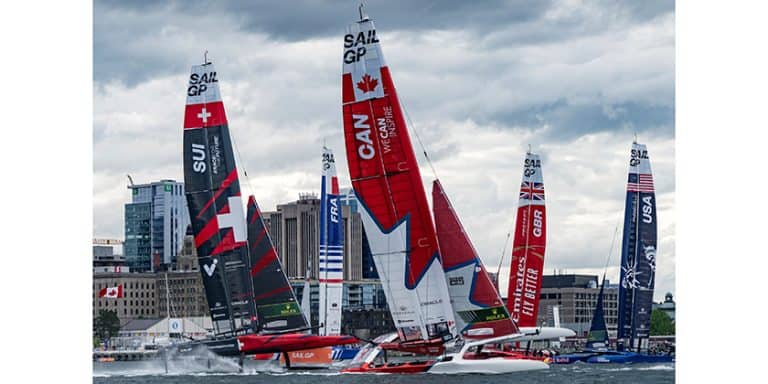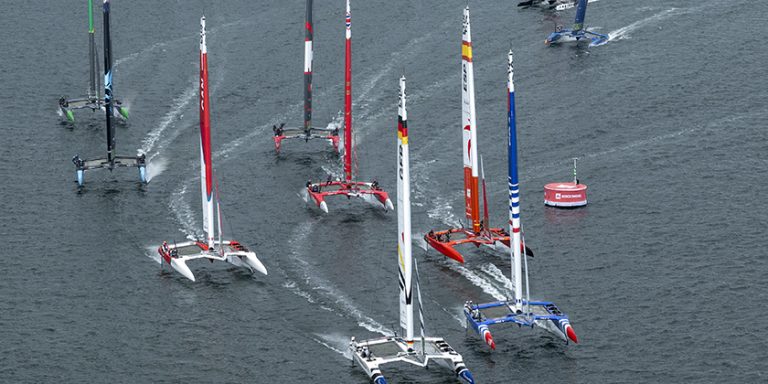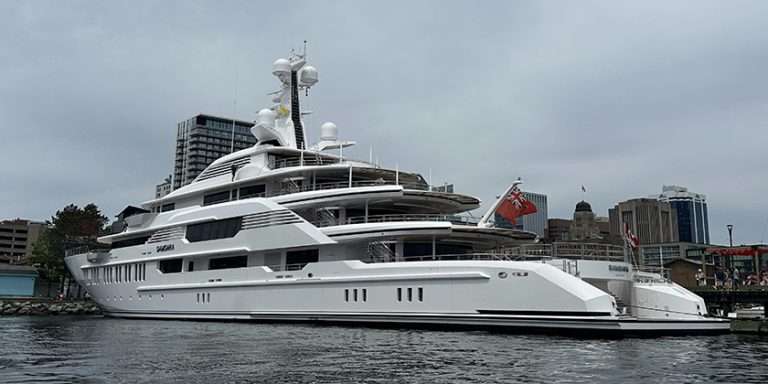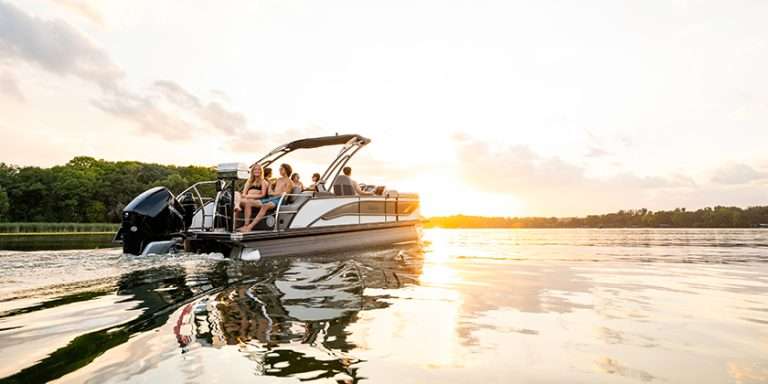Bedford Basin Yacht Club
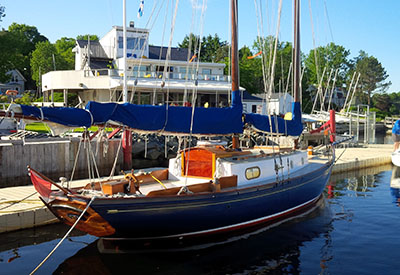
Katherine Stone
A social club based on sailing
The Halifax Harbour is well known not only to mariners and historians, but also to most Canadians for the 1917 Halifax explosion and the many fortifications left by the British. It has a rich and fascinating maritime history. The Bedford Basin, named after the 4th Duke of Bedford, is the remains of a large pre-historic fjord found in the northwestern end of Halifax Harbour measuring 8 kilometers in length and 5 km wide. A well- protected, deep harbour makes it ideal for anchoring. Due to these qualities, Halifax Harbour became the primary logistic port for resupplying Western Europe during both World Wars. With its protected waters, Bedford Basin allowed the English and Canadian Navies to securely assemble merchant convoys. With torpedo nets set in Halifax Harbour, German submarines were kept at bay.
The northern part of the basin saw skirmishes with the Mi’kmaq people in the early 1700s. By 1749 Fort Sackville had been completed by the British to help defend the area from attacks by the Native peoples, Acadians, and French. The area around the fort was known as Sackville, but was also referred to as Ten Mile House where stage coaches stopped to change horses and sleighing parties came for entertainment in the winter. The next 50 years saw the construction of paper mills, built on land grants. The Acadian Paper Mill provided paper for the Halifax
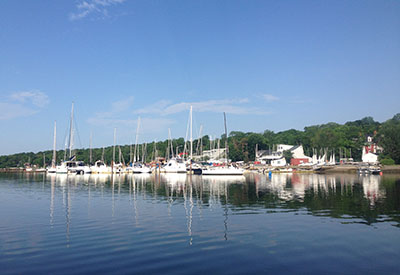
Acadian Recorder newspaper. After the Nova Scotia Railway (now CNR) was constructed, most people were referring to Sackville as Bedford, but the name did not become official until an Act of Legislation in 1896. Bedford was incorporated as a town in 1980, but absorbed into the Halifax Regional Municipality in more recent times.
Harry DeWolf, another famous icon hails from Bedford. As commander of many ships he saw his fair share of action on the seas. Cdr. DeWolf took control of HMS Haida in 1943, sinking 14 enemy ships in just over a year, earning a reputation as “The Fightingest Ship in the Canadian Navy.” DeWolf earned the reputation of being a skillful, fearless tactician and for bold manoeuvres. He crew fondly referred to him as “Hard-Over-Harry”. In honour of his outstanding service he not only earned the Distinguished Service Order, but the Town of Bedford named the Admiral Harry DeWolf waterfront park after him in 1992. An offshore patrol vessel built in 2014, specifically for the Arctic, is also named Harry DeWolf. A popular walkway begins at DeWolf Park and many of the Bedford Basin Yacht Club festivities take place in the park. An ideal community, in 1997 Macleans Magazine rated Bedford the “Best Community to Live in Canada.” Not only does it house a well-established sailing community, it is also the home of the Maritime Road Hockey League (what one can do when not boating)!
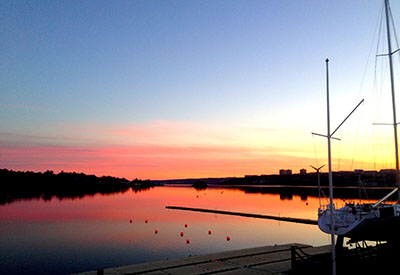
The formation of a summer sailing community in Bedford Basin started prior to World War II, as the area started to grow with the construction of cottages. By the 1940s a group of like-minded boaters had rented a facility on the shore in the basin and finally incorporated the Bedford Basin Yacht Club in 1954. In 1956 the old Bedford Tennis Club was purchased as a clubhouse. There were many renovations since then to modernize the building but it finally came time to build a new one. Jamie O’Hagan, Past Commodore, recalls that, “They built the new clubhouse adjacent to the old building. When it came time to disconnect all the services, they punched a hole in the wall of the old clubhouse and moved the 30 foot bar from the old to the new building without interrupting bar service!”
Racing was a big part of this yacht club over the years, with Rear Admiral Harry DeWolf firing a gun off his cottage lawn to start the races. The fleets over the years included Etchells, J/24s, PHRF, Finns, Solings, Fireballs, and of course, Bluenoses. The last 10 years have seen changes from racing to more social activities at the club, bigger boats, more power boats, and focus on fun beer can races. The Niagara 26 sailboats are a mainstay of the club races as they are sailed with just a main and #3 jib – truly a mom and pop boat! Starting out as a relaxed, community based club, it has now returned to those days. “The active social program includes a Friday Night BBQ where you can
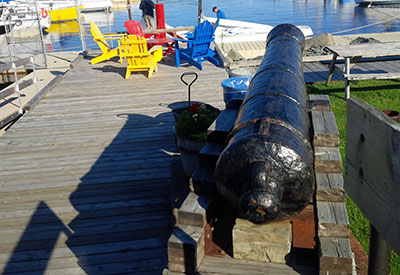
buy a bottle of wine, salmon or beef steak or lamb chops and walk there and back and not have to worry about too many glasses of wine. The BBQ is a labour of love done by Richard O’Brian who organizes each one,” recounts Rob Williams, now an International Race Officer and member since 1974.
As a small community club, BBYC relies on volunteer help. Although there are no required work hours, you never have to ask the members, as the work always gets done. Currently they sit at approximately 150 family memberships and 44 slips, with the balance of boats dry-sailed or on moorings. Started in 1972, the ARK Junior regatta brings together young sailors from Atlantic Canada. BBYC continues to jointly run the Halifax Harbour Race with the Royal Nova Scotia Yacht Squadron for the benefit of the provincial sailing team since 1976, originally sailed in Bluenoses.
In the 1990s you would see 30-40 women show up for Friday night racing. Sadly, this trend started to disappear. Kate Pepler, the Head Instructor of Bedford Basin Yacht Club, attended the Atlantic Sailing Conference in November, where she heard a talk by Nick Hayes, author of Saving Sailing. This inspired her to launch an initiative at BBYC to engage more women in sailing. The result has been a
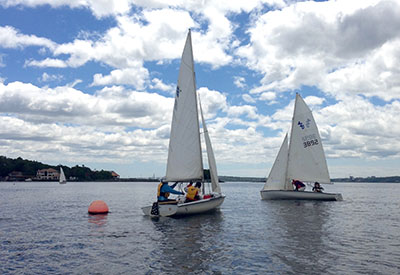
revamped Women’s Learn to Sail (LTS) program at BBYC. Four weekend workshops have been planned over the summer, specifically aimed at getting women on the water, and helping them gain the confidence to sail and skipper boats. These weekends are designed to be fun and informative by sailing both dinghies and keelboats. The ladies are given the theory behind sailing to figure out how the boats work, and then put the theory into practice on the water.
Although a strong asset of the club, BBYC’s learn to sail program is now also on the rise again! This summer they have the highest registration numbers they have seen in a long time, and many of the programs are completely full! Part of this is due to the initiative that Kate took to keep their sailors engaged throughout the winter with a Holiday dinner, a float in the Bedford Parade of Lights, and a skate at the Halifax Emerald Oval! She knows that it’s important to keep in touch with sailing friends throughout the year, as they often turn into lifelong friendships. They have also started a Wetfeet program for sailors aged six to nine and have Monday night dinghy races for all kids. Basin races with Dartmouth Yacht Club sailing school on Wednesdays also continue to be popular with the kids which are a great way for them to train and hone their skills. Sail All, a non-profit organization formed by the Lunenburg YC in 2013, has now involved BBYC and the Hubbard’s Sailing Club. Their aim is to get more kids out on the water and make sailing more accessible.
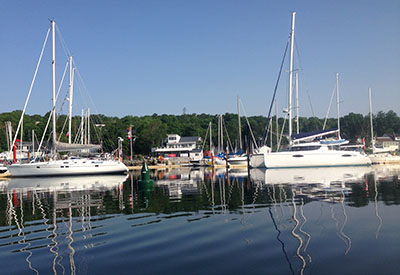 Warren Nethercote joined the club in the 1980s because it was so friendly. Although he no longer owns a boat there, he still enjoys going down there to sail with friends. He calls it a social club based on sailing! Having a strong junior sailing program allows children to make lifelong friends and it sounds like this club has put a lot of stock into their young people to get them and keep them interested in being out on the water. Come join the fun!
Warren Nethercote joined the club in the 1980s because it was so friendly. Although he no longer owns a boat there, he still enjoys going down there to sail with friends. He calls it a social club based on sailing! Having a strong junior sailing program allows children to make lifelong friends and it sounds like this club has put a lot of stock into their young people to get them and keep them interested in being out on the water. Come join the fun!
Bedford Basin YC; 377 Shore Drive; Bedford, NS; B4A 2C7; 902-835-3729 bbyc@ns.sympatico.ca
Photo Captions:
Photo 1 – View of Club house with a schooner at marina berth in foreground.
Photo 2 – A full harbour of mooring balls and docks.
Photo 3 – Sunset at BBYC December 2014.
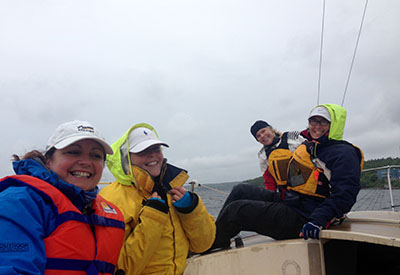 Photo 4 – Club’s Cannon view over new 44 berth marina to starting line. Cannon is French circa 1770.
Photo 4 – Club’s Cannon view over new 44 berth marina to starting line. Cannon is French circa 1770.
Photo 5 – Women’s workshop – 420.
Photo 6 – Calm waters don’t always make for the best sailing!
Photo 7 – Women’s workshop J24.


